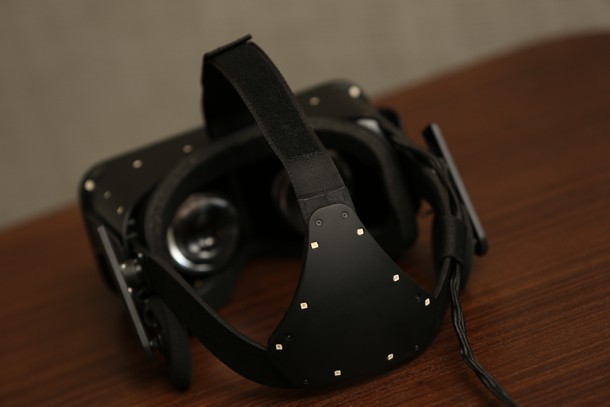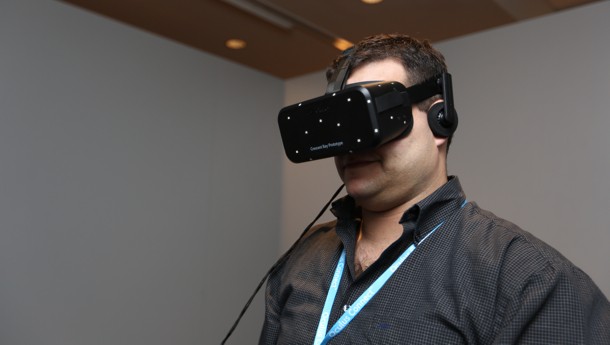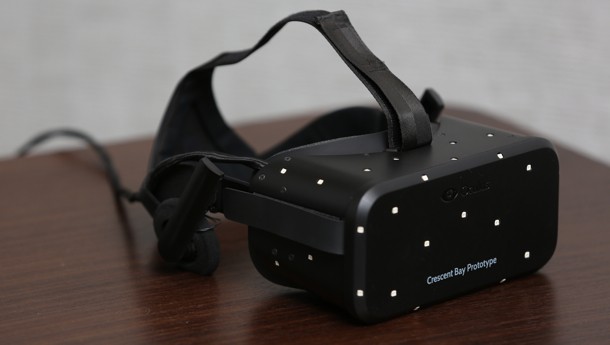Walking (Yes, Walking) Through Oculus' Outstanding Crescent Bay Prototype Demo

Oculus has been consistent on a number of key points: The company won't release a virtual reality product until it's good enough. There's a sense of openness about the VR race that encourages competition. Oculus Rift is a seated experience.
This last point is one I've mentioned a number of times in previous VR writeups, because there are others who are trying to create holodeck experiences or simply encourage stationary standing. Not Oculus. Everytime we've spoken with the team, there's been a reinforcement that the Rift is meant for couch (or swivel chair) usage.
The newly announced Crescent Bay feature prototype revealed at Oculus Connect offers a number of improvements. It includes positional audio (though not 360-degree yet), improved persistence, and tracking LEDs on the back of the unit. And while it's not designed as a standing experience, according to CEO Brendan Iribe, that is how Oculus chose to show it to attendees at Oculus Connect.
“To give the strongest sense of presence, standing up helps. It does,” Iribe tells us. “Sitting down, it’s still incredibly impactful, and I did the room many times sitting down. Standing up, it is a little more awesome. Just the way the brain works, I’m a little more convinced. Sitting down, you’re feeling [the chair]. When you’re standing up, and all there is are your clothes on your body, you’re less reminded that you’re not really there. We wanted to give the strongest sense of presence for everybody at Connect.”
I was led into a small room with a large rubber mat in the middle. The fragile new Crescent Bay unit (only built in the last few days at Oculus headquarters) was put on my head, the onboard earphones flipped into position by an Oculus staff member.
I was free to walk around a little, though I was still tethered. The demo opened with a submarine setting designed to ease users into the experience. In front of me was a periscope that felt real enough to touch (we’re not there yet though, as there was no input mechanism for this demo).
As the submarine faded from view, I was placed in a black room with a very large, very toothy dinosaur. This was a good opportunity to test the aural positioning.

It wasn’t as smooth as Project Morpheus, but it did drive home the same feeling I had with Sony’s prototype: VR sound is more about software than it is about hardware. I want to use high-end earbuds for sure, but the unassuming built-in drivers certainly got the job done.
Other demos included an origami forest, a Tron-like dream sequence, and another dinosaur encounter. This time, a T-Rex stomped through the halls of a museum. I won’t lie, as it neared me, I wondered what it would feel like to be stomped or chomped by the huge beast.
The most impactful moment though, was a brief Batman simulator. No, this isn’t an official Dark Knight demo, but I was on the top of a skyscraper on a ledge in a city that could easily have been Gotham.
Peering around revealed a blimp in the air, cars below, a thrumming city full of life. I decided I was going to be a tough guy and step off the small perch I was on. As someone who is more than a little afraid of heights, this was going to be a challenge, because as I looked down, I got that familiar feeling in my stomach and impulse to back away.
One step. I can do this.
Another step. This is going to be weird.
And then, I took what would have been my penultimate step before falling to my doom or doing my best Wile E. Coyote impression. As my foot dropped, I felt the edge…or at least I thought I had.
I recoiled. What was I thinking? Ever so briefly, I was convinced that I was going to die and then I realized that I hadn’t hit the edge of the perch at all. I had reached the edge of the raised rubber mat, and my foot tipped forward on the slope toward the room floor.
Mission accomplished, Oculus. My brain was convinced I was on that ledge. I chuckled to myself, but before I could will myself to give it another go, the scene started to fade.

The final moments of the Crescent Bay demo were delivered by Epic Games. The scene, called Showdown, shows futuristic police officers squaring off against a giant mechanoid. I remember seeing the Oculus HD “Elemental” demo for the first time and being blown away. Showdown on Crescent Bay dwarfs it.
The resolution and frame rate are significantly improved from the DK2 (though Oculus wasn’t ready to disclose specific weight and technical specs). If there is persistence, smearing, or screen door effect, I did not notice it on my single time through the experience.
In Showdown, the camera takes us down the street in exaggerated slow motion. Bullets distort the air as they whiz by. I instinctively move out of their way, not unlike the Superhot demo I tried at E3.
As the carnage ramps up, debris starts flying, glass shatters, bodies fall around me. And then, the most amazing VR moment I’ve had begins, as a car is rocketed from the street and flips overhead. Looking up reveals the terrified faces of its passengers, hanging upside down only by their seat belts.
The debris field becomes unavoidable. Rock, glass, bullets, sheared metal, and more pass through me. I am awestruck not just by Epic’s signature brand of carnage, but by how absolutely clear and convincing the illusion is.
In virtual reality, the ultimate goal is to trick the brain thoroughly that it is immersed in the scene. Pixelation, smearing, and dips in framerate all serve to yank the sense of presence away. I experienced none of that.
According to CEO Brendan Iribe, the company isn’t ready to talk about the consumer model, but they are getting close. Crescent Bay is an enormous step toward putting an Oculus Rift in homes, and if this is close to the experience available on day one, the biggest hurdle isn’t going to be convincing people. It will be giving as many potential customers eyes-on time to make them believers.
“Along the path, along this journey of making VR happen, there have a been a series of improvements and demos,” says Iribe, speaking about Crescent Bay as the latest feature prototype. “For us, seeing that quality of VR and that sense of presence was the most important thing we’d seen along the way. It's only going to get better. Consumer VR will be at least as good or better."









